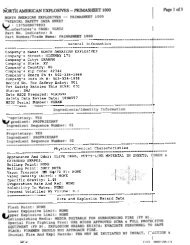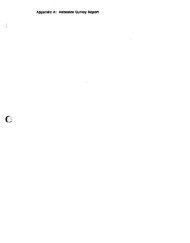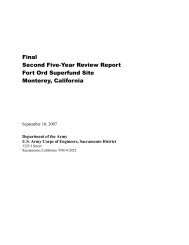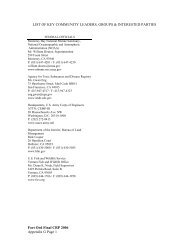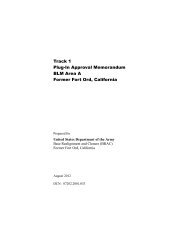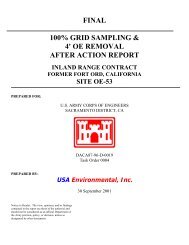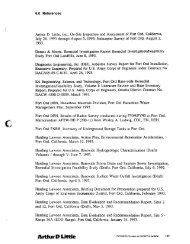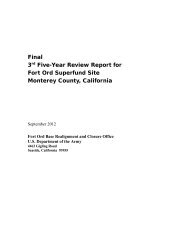appendix a activity hazard analysis forms - Former Fort Ord ...
appendix a activity hazard analysis forms - Former Fort Ord ...
appendix a activity hazard analysis forms - Former Fort Ord ...
Create successful ePaper yourself
Turn your PDF publications into a flip-book with our unique Google optimized e-Paper software.
HydroGeoLogic, Inc. – Site Safety & Health Plan Fritzsche Army Airfield Fire Drill Area—<strong>Former</strong> <strong>Fort</strong> <strong>Ord</strong>, California<br />
APPENDIX A<br />
ACTIVITY HAZARD ANALYSIS FORMS<br />
U.S. Army Corps of Engineers<br />
Appendix A.doc HydroGeoLogic, Inc. 8/2/04
HydroGeoLogic, Inc. – Site Safety & Health Plan Fritzsche Army Airfield Fire Drill Area—<strong>Former</strong> <strong>Fort</strong> <strong>Ord</strong>, California<br />
This <strong>appendix</strong> is reserved for <strong>activity</strong> <strong>hazard</strong> <strong>analysis</strong> <strong>forms</strong> which set forth the tasks, <strong>hazard</strong>s<br />
and control measures to provide safe work practices for operations at the project site.<br />
NOTE: EACH ACTIVITY MUST BE REANALYZED FOR EACH DELIVERY ORDER<br />
• Groundwater Sampling<br />
• Mobilization<br />
• Drilling<br />
• Soil Sampling<br />
• Well Installation<br />
• Decontamination of Equipment<br />
• Disposition of Investigation Derived Waste<br />
• Demobilization<br />
• Excavation and Trenching<br />
• Installation of Groundwater Extraction Treatment Systems<br />
• Groundwater Extraction Treatment System O&M<br />
U.S. Army Corps of Engineers<br />
Appendix A.doc HydroGeoLogic, Inc. 8/2/04
ACTIVITY HAZARD ANALYSIS<br />
ACTIVITY: Groundwater Sampling Reviewed By: Mary Ann Heaney<br />
PRINCIPAL STEPS POTENTIAL SAFETY / HEALTH HAZARDS RECOMMENDED CONTROLS<br />
Staging equipment<br />
Slip, trip, and fall <strong>hazard</strong>s<br />
Determine best access route before transporting equipment.<br />
Good housekeeping, keep work area picked up and clean as feasible.<br />
Continually inspect the work area for slip, trip and fall <strong>hazard</strong>s.<br />
Look before you step, insure safe and secure footing.<br />
Heavy lifting Use proper lifting techniques. Lifts greater than 60 pounds require assistance<br />
or mechanical equipment; size up the lift.<br />
Falling objects Stay alert and clear of materials suspended overhead. Wear hard hat and steel<br />
toes boots.<br />
Flying debris, dirt, dust, etc. Use safety glasses/goggles. Ensure that eye wash is in good working order.<br />
Pinch points<br />
Fire<br />
Keep hands, fingers, and feet clear of moving/suspended materials and<br />
equipment.<br />
Beware of contact points.<br />
Stay alert at all times.<br />
Fire extinguishers shall be suitably placed, distinctly marked, readily<br />
accessible, and maintained in a fully charged and operable condition.<br />
All flammable liquids will be transported in UL/FM approved containers and<br />
sources of ignition will be prohibited.<br />
Contact with moving equipment/vehicles<br />
Work area will be barricaded/demarcated.<br />
Equipment will be laid out in a area free of traffic flow.<br />
Bees, spiders and snakes Inspect work area carefully and avoid placing hands and feet into concealed<br />
areas.<br />
Cut <strong>hazard</strong>s Wear adequate hand protection. Use care when handling glassware.<br />
Chemical exposure<br />
Initial real time air monitoring will take place.<br />
Proper use of PPE.<br />
Label all containers as to contents and disposes of properly.<br />
Site Safety and Health Plan.doc HydroGeoLogic, Inc. 8/2/04
ACTIVITY HAZARD ANALYSIS<br />
ACTIVITY: Groundwater Sampling Reviewed By: Mary Ann Heaney<br />
PRINCIPAL STEPS POTENTIAL SAFETY / HEALTH HAZARDS RECOMMENDED CONTROLS<br />
Staging equipment (continued)<br />
Sample collection<br />
Chemical exposure (continued) Obtain Material Safety Data Sheets for solvents, etc. that are being used.<br />
Noise Sound levels above 85 dBA mandates hearing protection.<br />
Electrical shock All electrical circuits will be de-energized and locked out.<br />
Bees spiders and snakes Inspect work areas carefully and avoid placing hands and feet into concealed<br />
areas.<br />
Cross-contamination and contact with potentially<br />
contaminated materials<br />
Cut <strong>hazard</strong>s<br />
Chemical exposure<br />
Strains/sprains<br />
Sampling technicians will wear proper protective clothing and equipment to<br />
safeguard against potential contamination.<br />
Only essential personnel will be in the work area.<br />
Initial real-time air monitoring will take place before and during sampling<br />
activities.<br />
All personnel will follow good hygiene practices.<br />
Proper decontamination procedures will be followed.<br />
All liquids and materials used for decontamination will be contained and<br />
disposed of in accordance with Federal, State and Local regulations.<br />
Use care when handling glassware.<br />
Wear adequate hand protection.<br />
Label all containers as to contents.<br />
Proper use of PPE.<br />
Use the proper tool for the job being performed.<br />
Get assistance if needed.<br />
Avoid twisting/turning while pulling tools, grates, manway covers, etc.<br />
Spills/residual materials Absorbent materials and containers will be kept available where leaks or<br />
spills may occur.<br />
Site Safety and Health Plan.doc HydroGeoLogic, Inc. 8/2/04
ACTIVITY HAZARD ANALYSIS<br />
ACTIVITY: Groundwater Sampling Reviewed By: Mary Ann Heaney<br />
PRINCIPAL STEPS POTENTIAL SAFETY / HEALTH HAZARDS RECOMMENDED CONTROLS<br />
Sample collection (continued)<br />
Lighting Adequate lighting will be provided to insure a safe work environment.<br />
Unattended worker “Buddy System” – Visual contact will be maintained with the sampling<br />
technician during sampling activities.<br />
Equipment decontamination Chemical exposure Maintain MSDS for all chemicals such as methanol or hexane and follow<br />
protection procedures.<br />
Moving and shipping collected<br />
samples<br />
Heavy lifting Use proper lifting techniques. Lifts of greater than 60 pounds require<br />
assistance or mechanical equipment; size up the lift.<br />
Pinch points<br />
Keep hands, fingers, and feet clear of moving/suspended materials and<br />
equipment.<br />
Beware of contact points.<br />
Stay alert at all times<br />
Cut <strong>hazard</strong>s Wear adequate hand protection. Use care when handling glassware.<br />
Chemical exposure Label all containers as to contents and associated <strong>hazard</strong>s.<br />
Equipment To Be Used Inspection Requirements Training Requirements<br />
Hand tools<br />
PPE<br />
Sampling equipment<br />
Pre-post maintenance<br />
Visual prior to use<br />
Tailgate Safety Meeting<br />
Site specific orientation<br />
Hazardous waste operations<br />
Hazard communication<br />
Site Safety and Health Plan.doc HydroGeoLogic, Inc. 8/2/04
ACTIVITY HAZARD ANALYSIS<br />
ACTIVITY: Mobilization Reviewed By: Mary Ann Heaney<br />
PRINCIPAL STEPS POTENTIAL SAFETY/ HEALTH HAZARDS RECOMMENDED CONTROLS<br />
Installation of office and support<br />
structures<br />
Slip, trip and fall <strong>hazard</strong>s<br />
Determine best access route before transporting equipment.<br />
Good Housekeeping, keep work area picked up and clean as feasible.<br />
Continually inspect the work area for slip, trip and fall <strong>hazard</strong>s.<br />
Look before you step, ensure safe and secure footing.<br />
Heavy lifting Use proper lifting techniques. Lifts greater than 60 lbs. Require assistance or<br />
mechanical equipment; size-up the lift.<br />
Falling objects Hardhat, stay alert and clear of materials suspended overhead, steel-toed<br />
boots.<br />
Flying debris, dirt, dust, etc., Use safety glasses/goggles. Ensure that the eye wash station is in good<br />
working order.<br />
Noise Hearing protection is mandatory above 85 dBA.<br />
Pinch points<br />
Fire<br />
Vehicle traffic<br />
Keep hands and feet clear of moving/suspended materials and equipment.<br />
Stay alert at all times.<br />
Beware of contact points.<br />
Fire extinguishers shall be suitably placed, distinctly marked, readily<br />
accessible and maintained in a fully charged and operable condition.<br />
Fire lanes providing access to all areas shall be established and maintained<br />
free of obstruction (the minimum space between one-story non-fire-resistant<br />
buildings shall be 20 feet). Initial survey of the suitability and effectiveness<br />
of fire prevention and protection measures and facilities at each installation<br />
shall be made by competent persons.<br />
Fuel will be transported and stored in approved containers.<br />
Pay attention at all times.<br />
Wear high visibility clothing.<br />
Make sure that operators of vehicles know that you are near their equipment.<br />
Site Safety and Health Plan.doc HydroGeoLogic, Inc. 8/2/04
ACTIVITY HAZARD ANALYSIS<br />
ACTIVITY: Mobilization Reviewed By: Mary Ann Heaney<br />
PRINCIPAL STEPS POTENTIAL SAFETY/ HEALTH HAZARDS RECOMMENDED CONTROLS<br />
Installation of office support<br />
structures (continued)<br />
Vehicle traffic (continued)<br />
A spotter will aid in the backing of all vehicles with poor rear visibility.<br />
Work area will be barricaded/demarcated.<br />
Contact with utilities Above and underground utilities shall be located. A qualified person shall<br />
install required utilities in compliance with national, state, and local codes.<br />
Cut <strong>hazard</strong>s Wear adequate hand protection.<br />
Biological <strong>hazard</strong>s<br />
Hazardous plants (poison oak, sumac, ivy), insects,<br />
snakes, etc.<br />
Inspect work area carefully and avoid placing hands or feet into concealed<br />
areas.<br />
Be alert for bees, spiders, ticks and snakes.<br />
Remove vegetation, identify <strong>hazard</strong>ous plants, insects, etc.<br />
Flood potentials Check meteorology/climatology of the area. Look for any history of<br />
flooding.<br />
Toilets Chemical toilets provided in accordance with the SSHP.<br />
Heat Stress Refer to the appropriate section of the SSHP.<br />
High winds Mobile/portable facilities shall be anchored to withstand high winds.<br />
Hazard communication<br />
Mobilization of trailers Driving over soft ground<br />
Label all containers as to contents (fuel cans, etc.).<br />
Obtain Material Safety Data Sheets for materials brought on site.<br />
Contact with potentially contaminated materials No exclusion zone activities are associated with this task.<br />
Strains and sprains Use the proper tool for the job being performed.<br />
Make initial visual check. Level ground and spread gravel if needed.<br />
Apply gravel if needed to prevent mud or standing water. Loader (if used for<br />
spreading of grading) must meet all safety requirements.<br />
Site Safety and Health Plan.doc HydroGeoLogic, Inc. 8/2/04
ACTIVITY HAZARD ANALYSIS<br />
ACTIVITY: Mobilization Reviewed By: Mary Ann Heaney<br />
PRINCIPAL STEPS POTENTIAL SAFETY/ HEALTH HAZARDS RECOMMENDED CONTROLS<br />
Mobilization of trailers (continued)<br />
Level/Blocking trailer, driving stakes (stabilization)<br />
anchoring<br />
Use caution when jacking and placing blocks or cribbing. If ground is soft,<br />
add stone to secure footing.<br />
Setting steps in place Steps must be OSHA-approved (with proper handrails, mid-rail, steps, with a<br />
platform in front of the door. Refer to USACE 385-1-1 Section 21.E 02, 05,<br />
07, 08).<br />
Electric shock Lighting for work and means of egress; electrical hookup to trailers to be<br />
made by qualified electrician, GFCIs required on all circuits.<br />
Ventilation Trailer ventilation shall not bring in exhaust from vehicles, etc.<br />
EQUIPMENT TO BE USED INSPECTION REQUIREMENTS TRAINING REQUIREMENTS<br />
Hand tools<br />
PPE<br />
Heavy Equipment<br />
Vendor trucks<br />
Pre/post maintenance<br />
Visual prior to use<br />
Tailgate Safety Meeting<br />
Site specific orientation<br />
Hazard communication<br />
Site Safety and Health Plan.doc HydroGeoLogic, Inc. 8/2/04
ACTIVITY HAZARD ANALYSIS<br />
ACTIVITY: Drilling Reviewed By: Mary Ann Heaney<br />
PRINCIPAL STEPS POTENTIAL SAFETY/ HEALTH HAZARDS RECOMMENDED CONTROLS<br />
Drilling/boring<br />
Slip, trip, and fall <strong>hazard</strong>s Good housekeeping, keep work area picked up and as clean as feasible.<br />
Continually inspect the work area for slip, trip and fall <strong>hazard</strong>s.<br />
Strains and sprains, heavy lifting Use proper lifting techniques, lifts greater than 60 pounds require assistance or<br />
mechanical equipment; size up the lift.<br />
Falling objects Hardhat, stay alert and clear of materials suspended overhead, steel-toed boots.<br />
Flying debris, dirt, dust, etc. Use safety glasses/goggles. Ensure that the eye wash station is in good<br />
working order.<br />
Noise Noise levels above 85 dBA mandates hearing protection.<br />
Pinch points<br />
Keep feet and hands clear of moving/suspended materials and equipment.<br />
Beware of contact points.<br />
Stay alert at all times.<br />
Contact with overhead power lines Minimum overhead clearance shall be in accordance with Table 3.4.<br />
Fire The drill rig or boring rig will be equipped with at least one dry chemical fire<br />
extinguisher having a minimum UL rating of 1A5BC.<br />
Underground utilities All underground utilities will be located prior to excavating.<br />
Open excavations HydroGeoLogic, Inc. Corporate HSP Procedure 6. 4 “Barricading for Work<br />
Site Protection” will be adhered to at all times.<br />
Cuts Wear adequate hand protection.<br />
Traffic<br />
Driving over soft ground<br />
Work area will be barricaded off.<br />
Personnel will wear high visibility vests for high visibility.<br />
Make initial visual check.<br />
Apply gravel if needed to prevent mud or standing water.<br />
Level ground with loader and spread gravel is necessary.<br />
Contact with poison oak Conduct visual inspection prior to work.<br />
Site Safety and Health Plan.doc HydroGeoLogic, Inc. 8/2/04
ACTIVITY HAZARD ANALYSIS<br />
ACTIVITY: Drilling Reviewed By: Mary Ann Heaney<br />
PRINCIPAL STEPS POTENTIAL SAFETY/ HEALTH HAZARDS RECOMMENDED CONTROLS<br />
Drilling/boring (continued)<br />
Contact with poison oak (continued) Wear PPE.<br />
Decon with soap if needed.<br />
Contact with contaminated materials Personnel will wear appropriate PPE for the operation. This may include<br />
chemical resistant gloves, boot covers, splash suit.<br />
Contact with drilling equipment<br />
Before any machinery or mechanized equipment is placed into service, it shall<br />
be inspected and tested by a competent mechanic and certified to be in safe<br />
operating condition.<br />
Equipment shall be inspected before being placed into service and at the<br />
beginning of each shift.<br />
Preventive maintenance procedures recommended by the manufacturer shall be<br />
followed.<br />
A lockout-tagout procedure shall be used for equipment found to be faulty or<br />
undergoing maintenance.<br />
Only qualified personnel shall operate machinery and mechanized equipment.<br />
Machinery or equipment requiring an operator shall not be permitted to run<br />
unattended.<br />
Machinery or equipment will not be operated in a manner that will endanger<br />
persons or property nor will the safe operating speeds or loads be exceeded.<br />
All machinery or equipment will be shut down and positive means taken to<br />
prevent its operation while repairs or manual lubrications are being done.<br />
All repairs on machinery or equipment will be made at a location that provides<br />
protection from traffic for repairpersons.<br />
Maintain eye contact with drill operator when entering zone of operation.<br />
Establish work zone around drill rig.<br />
All mobile equipment shall be equipped with a back-up alarm.<br />
Site Safety and Health Plan.doc HydroGeoLogic, Inc. 8/2/04
ACTIVITY HAZARD ANALYSIS<br />
ACTIVITY: Drilling Reviewed By: Mary Ann Heaney<br />
EQUIPMENT TO BE USED INSPECTION REQUIREMENTS TRAINING REQUIREMENTS<br />
Hand tools<br />
Pipe<br />
Heavy equipment<br />
Pre-post maintenance<br />
Visual prior to use<br />
Client required form<br />
Tailgate safety meetings<br />
Site specific orientation<br />
Hazardous waste operations<br />
Site Safety and Health Plan.doc HydroGeoLogic, Inc. 8/2/04
ACTIVITY HAZARD ANALYSIS<br />
ACTIVITY: Soil Sampling Reviewed By: Mary Ann Heaney<br />
PRINCIPAL STEPS POTENTIAL SAFETY/ HEALTH HAZARDS RECOMMENDED CONTROLS<br />
Staging equipment<br />
Slip, trip, and fall <strong>hazard</strong>s<br />
Determine best access route before transporting equipment.<br />
Good housekeeping, keep work area picked up and clean as feasible.<br />
Continually inspect the work area for slip, trip and fall <strong>hazard</strong>s.<br />
Look before you step, insure safe and secure footing.<br />
Heavy lifting Use proper lifting techniques. Lifts greater than 60 pounds require assistance<br />
or mechanical equipment; size up the lift.<br />
Falling objects Stay alert and clear of materials suspended overhead. Wear hardhat and steel<br />
toes boots.<br />
Flying debris, dirt, dust, etc.<br />
Pinch points<br />
Fire<br />
Contact with moving equipment/vehicles<br />
Use safety glasses/goggles. Ensure that the eye wash station is in good<br />
working order.<br />
Noise Sound levels above 85 dBA mandates hearing protection.<br />
Keep hands, fingers, and feet clear of moving/suspended materials and<br />
equipment.<br />
Beware of contact points.<br />
Stay alert at all times.<br />
Fire extinguishers shall be suitably placed, distinctly marked, readily<br />
accessible, and maintained in a fully charged and operable condition.<br />
All flammable liquids will be transported in UL/FM approved containers and<br />
sources of ignition will be prohibited.<br />
Work areas will be barricaded/demarcated.<br />
Equipment will be laid out in an area free of traffic flow.<br />
Wear high visibility clothing.<br />
Bees, spiders and snakes Inspect work area carefully and avoid placing hands and feet into concealed<br />
areas.<br />
Cuts Wear adequate hand protection. Use care when handling glassware.<br />
Site Safety and Health Plan.doc HydroGeoLogic, Inc. 8/2/04
ACTIVITY HAZARD ANALYSIS<br />
ACTIVITY: Soil Sampling Reviewed By: Mary Ann Heaney<br />
PRINCIPAL STEPS POTENTIAL SAFETY/ HEALTH HAZARDS RECOMMENDED CONTROLS<br />
Staging equipment (continued)<br />
Sample collection<br />
Chemical exposure<br />
Initial real time air monitoring will take place.<br />
Label all containers as to contents and disposes of properly.<br />
Obtain Material Safety Data Sheets for solvents, etc. that are being used.<br />
Proper use of PPE.<br />
Noise Sound levels above 85 dBA mandates hearing protection.<br />
Electrical shock All non-essential electrical circuits will be de-energized and locked out.<br />
Bees, spiders and snakes Inspect work areas carefully and avoid placing hands and feet into concealed<br />
areas.<br />
Cross-contamination and contact with potentially<br />
contaminated materials<br />
Sampling technicians will wear appropriate PPE in accordance with the<br />
SSHP.<br />
Only essential personnel will be in the work area.<br />
Initial real-time air monitoring will take place before and during sampling<br />
activities.<br />
All personnel will follow good hygiene practices.<br />
Proper decontamination procedures will be followed.<br />
All liquids and materials used for decontamination will be contained and<br />
disposed of in accordance with Federal, State and Local regulations.<br />
Cut <strong>hazard</strong>s<br />
Use care when handling glassware.<br />
Wear adequate hand protection.<br />
Chemical exposure Label all containers as to contents.<br />
Strains/sprains<br />
Use the proper tool for the job being performed.<br />
Get assistance if needed.<br />
Avoid twisting/turning while pulling tools, grates, manway covers, etc.<br />
Site Safety and Health Plan.doc HydroGeoLogic, Inc. 8/2/04
ACTIVITY HAZARD ANALYSIS<br />
ACTIVITY: Soil Sampling Reviewed By: Mary Ann Heaney<br />
PRINCIPAL STEPS POTENTIAL SAFETY/ HEALTH HAZARDS RECOMMENDED CONTROLS<br />
Sample collection (continued)<br />
Spills/residual materials Absorbent materials and containers will be kept available where leaks or<br />
spills may occur.<br />
Lighting Adequate lighting will be provided to insure a safe work environment.<br />
Unattended worker “Buddy System” – Visual contact will be maintained with the sampling<br />
technician during sampling activities.<br />
Equipment decontamination Chemical exposure Maintain MSDS for all chemicals such as methanol or hexane and follow<br />
protection procedures.<br />
Moving and shipping collected<br />
samples<br />
Heavy lifting Use proper lifting techniques. Lifts of greater than 60 pounds require<br />
assistance or mechanical equipment; size up the lift.<br />
Pinch points<br />
Keep hands, fingers, and feet clear of moving/suspended materials and<br />
equipment.<br />
Beware of contact points.<br />
Stay alert at all times.<br />
Cut <strong>hazard</strong>s Wear adequate hand protection. Use care when handling glassware.<br />
Chemical exposure Label all containers as to contents and associated <strong>hazard</strong>s.<br />
EQUIPMENT TO BE USED INSPECTION REQUIREMENTS TRAINING REQUIREMENTS<br />
Hand tools<br />
PPE<br />
Sampling equipment<br />
Pre-post maintenance<br />
Visual prior to use<br />
Tailgate Safety Meeting<br />
Site specific orientation<br />
Hazardous waste operations<br />
Hazard communication<br />
Site Safety and Health Plan.doc HydroGeoLogic, Inc. 8/2/04
ACTIVITY HAZARD ANALYSIS<br />
ACTIVITY: Well Installation Analyzed By: Mike Lawson<br />
PRINCIPAL STEPS POTENTIAL SAFETY/ HEALTH HAZARDS RECOMMENDED CONTROLS<br />
Staging equipment<br />
Slip, trip, and fall <strong>hazard</strong>s<br />
Determine best access route before transporting equipment.<br />
Good housekeeping, keep work area picked up and clean as feasible.<br />
Continually inspect the work area for slip, trip and fall <strong>hazard</strong>s.<br />
Look before you step, insure safe and secure footing.<br />
Heavy lifting Use proper lifting techniques. Lifts greater than 60 pounds require assistance<br />
or mechanical equipment; size up the lift.<br />
Falling objects Stay alert and clear of materials suspended overhead. Wear hardhat and steel<br />
toes boots.<br />
Flying debris, dirt, dust, etc.<br />
Pinch points<br />
Fire<br />
Contact with moving equipment/vehicles<br />
Use safety glasses/goggles. Ensure that the eye wash station is in good<br />
working order.<br />
Noise Sound levels above 85 dBA mandates hearing protection.<br />
Keep hands, fingers, and feet clear of moving/suspended materials and<br />
equipment.<br />
Beware of contact points.<br />
Stay alert at all times.<br />
Fire extinguishers shall be suitably placed, distinctly marked, readily<br />
accessible, and maintained in a fully charged and operable condition.<br />
All flammable liquids will be transported in UL/FM approved containers and<br />
sources of ignition will be prohibited.<br />
Work areas will be barricaded/demarcated.<br />
Equipment will be laid out in an area free of traffic flow.<br />
Wear high visibility clothing.<br />
Bees, spiders and snakes Inspect work area carefully and avoid placing hands and feet into concealed<br />
areas.<br />
Site Safety and Health Plan.doc HydroGeoLogic, Inc. 8/2/04
ACTIVITY HAZARD ANALYSIS<br />
ACTIVITY: Well Installation Analyzed By: Mike Lawson<br />
PRINCIPAL STEPS POTENTIAL SAFETY/ HEALTH HAZARDS RECOMMENDED CONTROLS<br />
Staging equipment (continued)<br />
Well installation<br />
Cuts Wear adequate hand protection. Use care when handling glassware.<br />
Chemical exposure<br />
Initial real time air monitoring will take place.<br />
Label all containers as to contents and disposes of properly.<br />
Obtain Material Safety Data Sheets for solvents, etc. that are being used.<br />
Open excavations HydroGeoLogic Inc Health and Safety Program Procedure 6.4 “Barricading<br />
for Work Site Protection” will be adhered to at all times.<br />
Noise Noise levels above 85 dBA mandates hearing protection.<br />
Drilling equipment operations Refer to Activity Hazard Analysis for Drilling.<br />
EQUIPMENT TO BE USED INSPECTION REQUIREMENTS TRAINING REQUIREMENTS<br />
Hand tools<br />
Pipe<br />
Heavy equipment<br />
Pre-post maintenance<br />
Visual prior to use<br />
Client required form<br />
Tailgate safety meetings<br />
Site specific orientation<br />
Hazardous waste operations<br />
Hazard communication<br />
Site Safety and Health Plan.doc HydroGeoLogic, Inc. 8/2/04
ACTIVITY HAZARD<br />
ACTIVITY: Decontamination of Equipment Reviewed by: Mary Ann Heaney<br />
PRINCIPAL STEPS POTENTIAL SAFETY/ HEALTH HAZARDS RECOMMENDED CONTROLS<br />
Movement to DECON area<br />
Noise Noise levels above 85 dBA mandates hearing protection.<br />
Contact with heavy equipment<br />
Contact with potentially contaminated materials<br />
A lockout-tagout procedure shall be used for equipment found to be faulty or<br />
undergoing maintenance.<br />
Only designated personnel shall operate machinery and mechanized<br />
equipment.<br />
Getting off or on any equipment while it is in motion is prohibited.<br />
Machinery or equipment requiring an operator shall not be permitted to run<br />
unattended.<br />
Machinery or equipment will not be operated in a manner that will endanger<br />
persons or property nor will the safe operating speeds or loads be exceeded.<br />
All machinery or equipment will be shut down and positive means taken to<br />
prevent its operation while decontamination is being done.<br />
Bulldozer and scraper blades, end-loader buckets, and similar equipment will<br />
be either fully lowered or blocked when being repaired or when not in use.<br />
All mobile equipment shall be equipped with a back-up alarm.<br />
Real time air monitoring will take place. Proper personal protective clothing<br />
and equipment will be utilized.<br />
Good housekeeping will be stressed to safe guard against cross contamination<br />
of surrounding areas and eliminate safety <strong>hazard</strong>s.<br />
All site personnel will practice good personal hygiene.<br />
The work area will be demarcated. All unnecessary personnel will be kept out<br />
of the work area and in an upwind location.<br />
Refer to SSHSP for chemical <strong>hazard</strong> discussion.<br />
Wear proper PPE.<br />
Site Safety and Health Plan.doc HydroGeoLogic, Inc. 8/2/04
ACTIVITY HAZARD<br />
ACTIVITY: Decontamination of Equipment Reviewed by: Mary Ann Heaney<br />
PRINCIPAL STEPS POTENTIAL SAFETY/ HEALTH HAZARDS RECOMMENDED CONTROLS<br />
Movement to DECON area<br />
Pressure Washing<br />
Strains and sprains, heavy lifting<br />
Cut <strong>hazard</strong>s/Cuts<br />
Good housekeeping, keep work area picked up and as clean as feasible.<br />
Continually inspect the work area for slip, trip and fall <strong>hazard</strong>s.<br />
Use proper lifting techniques, lifts greater than 60 pounds require assistance<br />
or mechanical equipment; size up the lift.<br />
Keep feet and hands clear of moving/suspended materials and equipment.<br />
Beware of contact points.<br />
Stay alert at all times.<br />
Wear adequate hand protection.<br />
Work area will be barricaded off to prevent entry by unauthorized<br />
individuals.<br />
Leg and metatarsal guards shall be worn.<br />
All connections shall be inspected prior to use of pressure equipment.<br />
Verification of the proper pressure shall be made prior to use of the<br />
equipment.<br />
LO/TO shall be used is work on the system must be performed.<br />
Eye Injuries Safety glasses or goggles AND a face shield shall be worn.<br />
Burns<br />
Rain suits or suits of equivalent material shall be worn to prevent direct<br />
contact with hot water.<br />
Decontamination or washing of PPE while on a person is prohibited.<br />
EQUIPMENT TO BE USED INSPECTION REQUIREMENTS TRAINING REQUIRMENTS<br />
Hand tools<br />
PPE<br />
Heavy equipment Dump Trucks<br />
Pre-post maintenance<br />
Visual prior to use<br />
Client required form<br />
Tailgate Safety Meeting<br />
Site specific orientation<br />
Hazardous waste operation<br />
Site Safety and Health Plan.doc HydroGeoLogic, Inc. 8/2/04
ACTIVITY HAZARD ANALYSIS<br />
ACTIVITY: Disposition of Investigation Derived Waste Analyzed By: Mike Lawson<br />
PRINCIPAL STEPS POTENTIAL SAFETY/ HEALTH HAZARDS RECOMMENDED CONTROLS<br />
Staging equipment<br />
Slip, trip, and fall <strong>hazard</strong>s<br />
Determine best access route before transporting equipment<br />
Good housekeeping, keep work area picked up and clean as feasible.<br />
Continually inspect the work area for slip, trip and fall <strong>hazard</strong>s.<br />
Look before you step, insure safe and secure footing.<br />
Heavy lifting Use proper lifting techniques. Lifts greater than 60 pounds require<br />
assistance or mechanical equipment; size up the lift.<br />
Falling objects Stay alert and clear of materials suspended overhead. Wear hardhat and<br />
steel toes boots.<br />
Flying debris, dirt, dust, etc.<br />
Pinch points<br />
Fire<br />
Contact with moving equipment/vehicles<br />
Use safety glasses/goggles. Ensure that the eye wash station is in good<br />
working order.<br />
Noise Sound levels above 85 dBA mandates hearing protection.<br />
Keep hands, fingers, and feet clear of moving/suspended materials and<br />
equipment.<br />
Beware of contact points.<br />
Stay alert at all times.<br />
Fire extinguishers shall be suitably placed, distinctly marked, readily<br />
accessible, and maintained in a fully charged and operable condition.<br />
All flammable liquids will be transported in UL/FM approved containers and<br />
sources of ignition will be prohibited.<br />
Work areas will be barricaded/demarcated.<br />
Equipment will be laid out in an area free of traffic flow.<br />
Bees, spiders and snakes Inspect work area carefully and avoid placing hands and feet into concealed<br />
areas.<br />
Cuts Wear adequate hand protection. Use care when handling glassware.<br />
Site Safety and Health Plan.doc HydroGeoLogic, Inc. 8/2/04
ACTIVITY HAZARD ANALYSIS<br />
ACTIVITY: Disposition of Investigation Derived Waste Analyzed By: Mike Lawson<br />
PRINCIPAL STEPS POTENTIAL SAFETY/ HEALTH HAZARDS RECOMMENDED CONTROLS<br />
Staging equipment (continued)<br />
Sample collection<br />
Chemical exposure<br />
Hazard communication<br />
Initial real time air monitoring will take place.<br />
Wear appropriate PPE.<br />
Label all containers as to contents and disposes of properly.<br />
Obtain Material Safety Data Sheets for solvents, etc. that are being used.<br />
Noise Sound levels above 85 dBA mandates hearing protection.<br />
Electrical shock All non-essential electrical circuits will be de-energized and locked out.<br />
Bees, spiders and snakes Inspect work areas carefully and avoid placing hands and feet into concealed<br />
areas.<br />
Cross-contamination and contact with potentially<br />
contaminated materials<br />
Cuts<br />
Chemical Exposure<br />
Strains/sprains<br />
Sampling technicians will wear appropriate PPE in accordance with the<br />
SSHP.<br />
Only essential personnel will be in the work area.<br />
Initial real-time air monitoring will take place before and during sampling<br />
activities<br />
All personnel will follow good hygiene practices.<br />
Proper decontamination procedures will be followed.<br />
All liquids and materials used for decontamination will be contained and<br />
disposed of in accordance with Federal, State and Local regulations.<br />
Use care when handling glassware.<br />
Wear adequate hand protection.<br />
Label all containers as to contents.<br />
Wear PPE.<br />
Use the proper tool for the job being performed.<br />
Get assistance if needed.<br />
Site Safety and Health Plan.doc HydroGeoLogic, Inc. 8/2/04
ACTIVITY HAZARD ANALYSIS<br />
ACTIVITY: Disposition of Investigation Derived Waste Analyzed By: Mike Lawson<br />
PRINCIPAL STEPS POTENTIAL SAFETY/ HEALTH HAZARDS RECOMMENDED CONTROLS<br />
Sample collection (continued)<br />
Strains/sprains (continued) Avoid twisting/turning while pulling tools, grates, manway covers, etc.<br />
Spills/residual materials Absorbent materials and containers will be kept available where leaks or<br />
spills may occur.<br />
Lighting Adequate lighting will be provided to insure a safe work environment.<br />
Unattended worker “Buddy System” – Visual contact will be maintained with the sampling<br />
technician during sampling activities.<br />
Equipment decontamination Chemical exposure Maintain MSDS for all chemicals such as methanol or hexane and follow<br />
protection procedures.<br />
Moving and shipping collected<br />
samples<br />
Heavy lifting Use proper lifting techniques. Lifts of greater than 60 pounds require<br />
assistance or mechanical equipment; size up the lift.<br />
Pinch points<br />
Keep hands, fingers, and feet clear of moving/suspended materials and<br />
equipment.<br />
Beware of contact points.<br />
Stay alert at all times.<br />
Cut <strong>hazard</strong>s Wear adequate hand protection. Use care when handling glassware.<br />
Hazard communication Label all containers as to contents and associated <strong>hazard</strong>s.<br />
EQUIPMENT TO BE USED INSPECTION REQUIREMENTS TRAINING REQUIREMENTS<br />
Hand tools<br />
PPE<br />
Sampling equipment<br />
Pre-post maintenance<br />
Visual prior to use<br />
Tailgate Safety Meeting<br />
Site specific orientation<br />
Hazardous waste operations<br />
Hazard communication<br />
Site Safety and Health Plan.doc HydroGeoLogic, Inc. 8/2/04
ACTIVITY HAZARD ANALYSIS<br />
Activity: Demobilization Reviewed by: Mary Ann Heaney<br />
PRINCIPAL STEPS POTENTIAL SAFETY/ HEALTH HAZARDS RECOMMENDED CONTROLS<br />
Removal of office and support<br />
structures<br />
Heavy lifting Use proper lifting techniques. Lifts greater than 60 pounds require<br />
assistance or mechanical equipment; size up the lift.<br />
Noise Hearing protection is mandatory above 85 dBA.<br />
Falling Objects Hardhat, stay alert and clear of materials suspended overhead, Steel<br />
toed boots required.<br />
Flying debris, dirt, dust etc. Safety glasses/eye wash.<br />
Pinch points<br />
Keep hands and feet clear of moving/suspended materials and<br />
equipment.<br />
Stay alert at all times.<br />
Beware of contact points.<br />
Fire Fire extinguishers shall be suitably placed, distinctly marked, readily<br />
accessible, and maintained in a fully charged and operable condition.<br />
Vehicle traffic<br />
Pay attention at all times. Wear high visibility vest.<br />
Make sure that operators of vehicles know that you are near their<br />
equipment.<br />
A spotter will aid in the backing of all vehicles with poor rear<br />
visibility.<br />
Contact with utilities Above and underground utilities shall be located. A qualified person<br />
shall install required utilities in compliance with national state, and<br />
local codes.<br />
Slip, trip, and fall <strong>hazard</strong>s<br />
Determine best access route before transporting equipment.<br />
Good housekeeping, keep work area picked up and clean as feasible.<br />
Continually inspect the work area for slip, trip, and fall <strong>hazard</strong>s.<br />
Look before you step, ensure safe and secure footing.<br />
Cut <strong>hazard</strong>s Wear adequate hand protection.<br />
Site Safety and Health Plan.doc HydroGeoLogic, Inc. 8/2/04
ACTIVITY HAZARD ANALYSIS<br />
Activity: Demobilization Reviewed by: Mary Ann Heaney<br />
Biological <strong>hazard</strong>s<br />
Inspect work area carefully and avoid placing hands or feet into<br />
concealed areas.<br />
Be alert for bees, spiders, ticks, and snakes.<br />
PRINCIPAL STEPS POTENTIAL SAFETY/ HEALTH HAZARDS RECOMMENDED CONTROLS<br />
Removal of office and support<br />
structures (Continued)<br />
Demobilization of trailers<br />
Contact with poison oak.<br />
Conduct visual inspection prior to work.<br />
Wear PPE.<br />
Decon with soap if needed.<br />
Toilets (sanitary) Chemical toilets provided in accordance with this SSHP.<br />
Heat stress Refer to Section 4.0 of the SSHP<br />
Fuel Fuel will be transported and stored in approved containers.<br />
Contact with moving equipment/vehicles Work area will be barricaded/demarcated.<br />
Contact with potentially contaminated materials No Exclusion Zone activities are associated with this task.<br />
Strains and sprains<br />
Use the proper tool for the job being performed.<br />
Get assistance if needed.<br />
Avoid twisting/tuning while pulling on tools, materials, etc.<br />
Unattended worker “Buddy System” visual contact will be maintained between personnel<br />
performing site activities.<br />
Driving over soft ground<br />
Make initial visual check. Level ground with loader and spread<br />
gravel.<br />
Apply gravel if needed to prevent mud or standing water. Loader (if<br />
used for spreading or grading) must meet all safety requirements.<br />
Removing/Blocking trailer, stakes and anchoring Use caution when jacking and removing blocks or cribbing. If<br />
ground is soft, add stone to secure footing.<br />
Site Safety and Health Plan.doc HydroGeoLogic, Inc. 8/2/04
ACTIVITY HAZARD ANALYSIS<br />
Activity: Demobilization Reviewed by: Mary Ann Heaney<br />
EQUIPMENT TO BE USED INSPECTION REQUIREMENTS TRAINING REQUIREMENTS<br />
Hand tools<br />
PPE<br />
Heavy equipment<br />
Vendor trucks<br />
Pre-post maintenance<br />
Visual prior to use<br />
Tailgate Safety Meeting<br />
Site specific orientation<br />
Hazard communication<br />
Site Safety and Health Plan.doc HydroGeoLogic, Inc. 8/2/04
Excavation<br />
ACTIVITY HAZARD ANALYSIS<br />
ACTIVITY: Excavation and Trenching Reviewed By: Mary Ann Heaney<br />
PRINCIPAL STEPS POTENTIAL SAFETY/ HEALTH HAZARDS RECOMMENDED CONTROLS<br />
Underground utilities All underground utilities will be located prior to excavating.<br />
Open excavations HydroGeoLogic Inc Corporate HSP procedure 6.2 “Excavation and<br />
Trenching Procedures” will be adhered to at all times.<br />
Noise Noise levels above 85 dBA mandates hearing protection.<br />
Contact with heavy equipment<br />
Before any machinery or mechanized equipment is placed into service, it<br />
shall be inspected and tested by a competent mechanic and certified to be in<br />
safe operating condition.<br />
Equipment shall be inspected before being placed into service and at the<br />
beginning of each shift.<br />
Preventive maintenance procedures recommended by the manufacturer shall<br />
be followed.<br />
A lockout-tagout procedure shall be used for equipment found to be faulty or<br />
undergoing maintenance.<br />
Machinery and mechanized equipment shall be operated only by designated<br />
personnel.<br />
Getting off or on any equipment while it is in motion is prohibited.<br />
Machinery or equipment requiring an operator shall not be permitted to run<br />
unattended.<br />
Machinery or equipment will not be operated in a manner that will endanger<br />
persons or property nor will the safe operating speeds or loads be exceeded.<br />
All machinery or equipment will be shut down and positive means taken to<br />
prevent its operation while repairs or manual lubrications are being done.<br />
All repairs on machinery or equipment will be made at a location which<br />
provides protection from traffic for repairpersons.<br />
Bulldozer and scraper blades, end-loader buckets, and similar equipment will<br />
be either fully lowered or blocked when being repaired or when not in use<br />
and whenever the operator leaves the machine.<br />
Site Safety and Health Plan.doc HydroGeoLogic, Inc. 8/2/04
ACTIVITY HAZARD ANALYSIS<br />
ACTIVITY: Excavation and Trenching Reviewed By: Mary Ann Heaney<br />
PRINCIPAL STEPS POTENTIAL SAFETY/ HEALTH HAZARDS RECOMMENDED CONTROLS<br />
Excavation (continued)<br />
Contact with heavy equipment (continued)<br />
All mobile equipment shall be equipped with a back-up alarm.<br />
Maintain eye contact with the operator at all times.<br />
Use spotter if necessary.<br />
Establish a work zone around equipment that protects personnel from swing<br />
radius.<br />
Contact with overhead power lines See overhead clearances in SSHP Table 3-5.<br />
Fire Each bulldozer, backhoe, or other similar equipment will be equipped with at<br />
least one dry chemical fire extinguisher having a minimum UL rating of<br />
1A5BC.<br />
Slip, trip, and fall <strong>hazard</strong>s Good housekeeping, keep work area picked up and as clean as feasible.<br />
Continually inspect the work area for slip, trip and fall <strong>hazard</strong>s.<br />
Pinch points<br />
Keep feet and hands clear of moving/suspended materials and equipment.<br />
Beware of contact points.<br />
Stay alert at all times.<br />
Strains and sprains, heavy lifting Use proper lifting techniques, lifts greater than 60 pounds require assistance<br />
or mechanical equipment; size up the lift.<br />
Cut <strong>hazard</strong>s Wear adequate hand protection.<br />
Traffic Work area will be barricaded off.<br />
EQUIPMENT TO BE USED INSPECTION REQUIREMENTS TRAINING REQUIREMENTS<br />
Hand tools<br />
PPE<br />
Heavy equipment<br />
Pre-post maintenance<br />
Visual prior to use<br />
Client required form<br />
Tailgate Safety Meetings<br />
Site specific orientation<br />
Hazardous waste operations<br />
Site Safety and Health Plan.doc HydroGeoLogic, Inc. 8/2/04
ACTIVITY HAZARD ANALYSIS<br />
ACTIVITY: Installation of Groundwater Extraction Treatment Systems Developed by: Mary Ann Heaney<br />
PRINCIPAL STEPS POTENTIAL SAFETY/HEALTH HAZARDS RECOMMENDED CONTROLS<br />
Installation of piping system<br />
Heavy Lifting Use proper lifting techniques. Lifts greater than 60 lbs require assistance or<br />
mechanical equipment. Size up the lift.<br />
Falling Objects Hardhat, stay alert and clear of materials suspended overhead, steel toed<br />
boots.<br />
Flying debris, dirt, dust, etc. Safety Glasses/eyewash.<br />
Slip trip and fall <strong>hazard</strong>s<br />
Cuts Wear adequate hand protection.<br />
Heat Stress<br />
Contact with poison oak.<br />
Contact with heavy equipment<br />
Determine bust access route before transporting equipment.<br />
Good housekeeping, keep work area picked up and clean as feasible.<br />
Continually inspect the work area for slip, trip and fall <strong>hazard</strong>s.<br />
Wear loose fitting, light colored clothing.<br />
Drink adequate water.<br />
Inspect work area visually.<br />
Wear PPE.<br />
Decon with soap if necessary.<br />
Before any machinery of mechanized equipment is placed into service, it<br />
shall be inspected and tested by a competent operator/mechanic and certified<br />
to be in safe operating condition.<br />
Only designated personnel shall operate machinery and mechanized<br />
equipment.<br />
Getting off or on any equipment while it is in motion is prohibited.<br />
Machinery of equipment requiring an operator shall not be permitted to run<br />
unattended.<br />
All mobile equipment shall be equipped with backup alarms.<br />
Site Safety and Health Plan.doc HydroGeoLogic, Inc. 8/2/04
ACTIVITY HAZARD ANALYSIS<br />
ACTIVITY: Installation of Groundwater Extraction Treatment Systems Developed by: Mary Ann Heaney<br />
PRINCIPAL STEPS POTENTIAL SAFETY/HEALTH HAZARDS RECOMMENDED CONTROLS<br />
Installation of piping system<br />
(continued)<br />
Installation of electrical units and<br />
pumps<br />
Driving over soft ground<br />
Failure of ropes, chains, slings, cables<br />
Make initial visual check.<br />
Ensure another vehicle available for assistance.<br />
Daily inspections of all lift equipment shall be performed.<br />
Rigging equipment shall not be loaded in excess of its recommended safe<br />
working load.<br />
Work or travel under elevated loads shall not be permitted.<br />
Ropes, slings, chains and hooks, elevated loads Taglines shall be used to control the loads being handled by hoisting<br />
equipment.<br />
Use of welding torches<br />
Contact with electrical current.<br />
Failure of ropes, chains, slings, cables<br />
Obtain a Hot Work Permit.<br />
Store and use compressed gases properly.<br />
Install radiation shields when welding in close proximity to other individuals.<br />
Ensure tat a fire extinguisher is in the immediate area.<br />
Follow Lockout/Tagout/Tryout Procedures when testing or starting<br />
equipment.<br />
Daily inspections of all lift equipment shall be performed.<br />
Rigging equipment shall not be loaded in excess of its recommended safe<br />
working load.<br />
Work or travel under elevated loads shall not be permitted.<br />
Heavy Lifting Use proper lifting techniques. Lifts greater than 60 lbs require assistance or<br />
mechanical equipment. Size up the lift.<br />
Site Safety and Health Plan.doc HydroGeoLogic, Inc. 8/2/04
ACTIVITY HAZARD ANALYSIS<br />
ACTIVITY: Installation of Groundwater Extraction Treatment Systems Developed by: Mary Ann Heaney<br />
EQUIPMENT TO BE USED INSPECTION REQUIREMENTS TRAINING REQUIREMENTS<br />
• Heavy equipment<br />
Hand tools<br />
Welding/cutting<br />
equipment<br />
• When equipment brought on site and before placed into<br />
operation<br />
• Tailgate safety meeting each morning and as needed<br />
through the day<br />
• Equipment operators must have proper authorization for the<br />
equipment they are using.<br />
• Electricians must be certified to perform the work they are<br />
assigned.<br />
Site Safety and Health Plan.doc HydroGeoLogic, Inc. 8/2/04
ACTIVITY HAZARD ANALYSIS<br />
ACTIVITY: Groundwater Extraction Treatment System O&M Analyzed By: Mary Ann Heaney<br />
PRINCIPAL STEPS POTENTIAL SAFETY/HEALTH HAZARDS RECOMMENDED CONTROLS<br />
Routine system operation and<br />
general maintenance<br />
Maintenance requiring system<br />
shutdown<br />
Heavy Lifting Use proper lifting techniques. Lifts greater than 60 lbs require assistance or<br />
mechanical equipment. Size up the lift.<br />
Falling Objects Hardhat, stay alert and clear of materials suspended overhead, steel toed<br />
boots.<br />
Flying debris, dirt, dust, etc. Safety Glasses/eyewash.<br />
Slip trip and fall <strong>hazard</strong>s<br />
Cut <strong>hazard</strong>s Wear adequate hand protection.<br />
Heat Stress<br />
Unexpected system activation<br />
Exposure to <strong>hazard</strong>ous materials<br />
Determine bust access route before transporting equipment.<br />
Good housekeeping, keep work area picked up and clean as feasible.<br />
Continually inspect the work area for slip, trip and fall <strong>hazard</strong>s.<br />
Wear loose fitting, light colored clothing.<br />
Drink adequate water.<br />
Implement Lock Out/Tag Out procedures in accordance with HydroGeoLogic,<br />
Inc. Corporate HSP Policy 6.3.<br />
Before any machinery of mechanized equipment is placed into service, it shall<br />
be inspected and tested by a competent operator/mechanic and certified to be<br />
in safe operating condition Machinery and mechanized equipment shall be<br />
operated only by designated personnel.<br />
Getting off or on any equipment while it is in motion is prohibited.<br />
Machinery of equipment requiring an operator shall not be permitted to run<br />
unattended.<br />
Initial monitoring of air in the breathing zone shall be performed before<br />
disconnecting any piping or appurtenances. Direct measurement of vapor<br />
concentrations within system equipment shall be performed immediately upon<br />
opening or disconnecting any system equipment.<br />
Proper use of PPE.<br />
Site Safety and Health Plan.doc HydroGeoLogic, Inc. 8/2/04
ACTIVITY HAZARD ANALYSIS<br />
ACTIVITY: Groundwater Extraction Treatment System O&M Analyzed By: Mary Ann Heaney<br />
PRINCIPAL STEPS POTENTIAL SAFETY/HEALTH HAZARDS RECOMMENDED CONTROLS<br />
Maintenance requiring system<br />
shutdown (continued)<br />
Driving over soft ground<br />
Contact with poison oak.<br />
Make initial visual check.<br />
Level ground with loader and spread gravel is necessary.<br />
Apply gravel if needed to prevent mud or standing water.<br />
Conduct visual inspection prior to work.<br />
Wear PPE.<br />
Decon with soap if needed.<br />
Electric shock Lighting for work and means of egress; electrical hookup to trailers to be<br />
made by qualified electrician, GFCIs required on all circuits.<br />
EQUIPMENT TO BE USED INSPECTION REQUIREMENTS TRAINING REQUIREMENTS<br />
• Heavy equipment<br />
Hand tools<br />
Welding/cutting<br />
equipment<br />
• When equipment brought on site and before<br />
placed into operation<br />
• Tailgate safety meeting each morning and as needed through the day<br />
OSHA 40 hour Hazardous Waste Training and 8 Hour Refresher as<br />
needed Equipment operators must have proper<br />
authorization for the equipment they are using.<br />
Site Safety and Health Plan.doc HydroGeoLogic, Inc. 8/2/04



